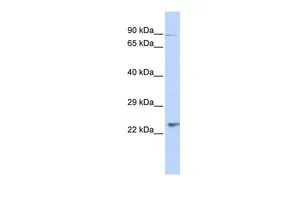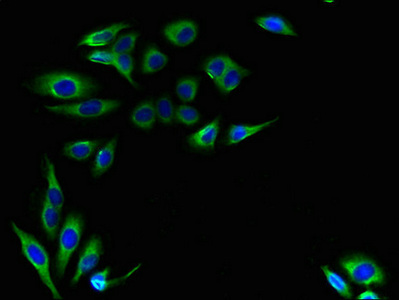
WB analysis of human heart tissue using GTX45273 LRRC51 antibody at 0.2-1microg/ml.
LRRC51 antibody, N-term
GTX45273
ApplicationsWestern Blot
Product group Antibodies
TargetLRTOMT
Overview
- SupplierGeneTex
- Product NameLRRC51 antibody, N-term
- Delivery Days Customer9
- Application Supplier NoteWB: 0.2-2.5 ug/ml. *Optimal dilutions/concentrations should be determined by the researcher.Not tested in other applications.
- ApplicationsWestern Blot
- CertificationResearch Use Only
- ClonalityPolyclonal
- Concentration0.5-1 mg/ml
- ConjugateUnconjugated
- Gene ID220074
- Target nameLRTOMT
- Target descriptionleucine rich transmembrane and O-methyltransferase domain containing
- Target synonymsCFAP111, DFNB63, LRRC51, LRRC51-TOMT, TOMT, transmembrane O-methyltransferase, leucine rich transmembrane and 0-methyltransferase domain containing
- HostRabbit
- IsotypeIgG
- Protein IDQ8WZ04
- Protein NameTransmembrane O-methyltransferase
- Scientific DescriptionThis gene has evolved in primates as a fusion of two ancestral neighboring genes, Lrrc51 and Tomt, which exist as two independent genes in rodents. The fusion gene contains some shared exons, but encodes structurally unrelated proteins, LRTOMT1 and LRTOMT2. Those variants that utilize the more centromere-proximal 3 terminal exon (short transcript form) encode LRTOMT1, while those variants that use a more centromere-distal 3 terminal exon (long transcript form) encode the LRTOMT2 protein. There is a small region within one of the exons of this gene that contains overlapping alternate reading frames for both LRTOMT1 and LRTOMT2. LRTOMT1 shares similarity with the protein encoded by mouse Lrrc51, while LRTOMT2 shares similarity with the protein encoded by mouse Tomt. Alternative splicing results in multiple transcript variants, encoding different isoforms of both LRTOMT1 and LRTOMT2. The LRTOMT1 protein is a leucine-rich repeat-containing protein, while the LRTOMT2 protein is a catechol-O-methyltransferase that catalyzes the transfer of a methyl group from S-adenosyl-L-methionine to a hydroxyl group of catechols and is essential for auditory and vestibular function. Mutations in this gene have been associated with nonsyndromic deafness. [provided by RefSeq, Nov 2017]
- Storage Instruction-20°C or -80°C,2°C to 8°C
- UNSPSC12352203





